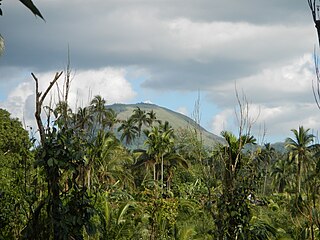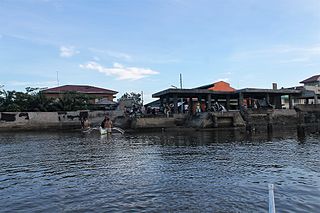
Batangas City, officially the City of Batangas, is a component city and capital of the province of Batangas, Philippines. According to the 2020 census, it has a population of 351,437 people.

Padre Burgos, officially the Municipality of Padre Burgos, is a municipality in the province of Quezon, Philippines. According to the 2020 census, it has a population of 23,488 people.

Luisiana, officially the Municipality of Luisiana, is a municipality in the province of Laguna, Philippines. According to the 2020 census, it has a population of 20,859 people.

Gumaca, officially the Municipality of Gumaca, is a municipality in the province of Quezon, Philippines. According to the 2020 census, it has a population of 71,942 people.

Santa Elena, officially the Municipality of Santa Elena, is a municipality in the province of Camarines Norte, Philippines. According to the 2020 census, it has a population of 43,582 people.

Buenavista, officially the Municipality of Buenavista, is a municipality in the province of Quezon, Philippines. According to the 2020 census, it has a population of 31,160 people.

Calauag, officially the Municipality of Calauag, is a municipality in the province of Quezon, Philippines. According to the 2020 census, it has a population of 71,809 people.

Dolores, officially the Municipality of Dolores, is a municipality in the province of Quezon, Philippines. According to the 2020 census, it has a population of 32,514 people.

Catanauan, officially the Municipality of Catanauan, is a municipality in the province of Quezon, Philippines. According to the 2020 census, it has a population of 72,752 people.

General Luna, officially the Municipality of General Luna, is a municipality in the province of Quezon, Philippines. According to the 2020 census, it has a population of 24,804 people.

Guinayangan, officially the Municipality of Guinayangan, is a municipality in the province of Quezon, Philippines. According to the 2020 census, it has a population of 44,045 people.

Macalelon, officially the Municipality of Macalelon, is a municipality in the province of Quezon, Philippines. According to the 2020 census, it has a population of 27,312 people.

Mulanay, officially the Municipality of Mulanay, is a municipality in the province of Quezon, Philippines. According to the 2020 census, it has a population of 55,576 people.

Plaridel, officially the Municipality of Plaridel, is a municipality in the province of Quezon, Philippines. According to the 2020 census, it has a population of 10,129 people.

Quezon, officially the Municipality of Quezon, is a municipality in the province of the same name. According to the 2020 census, it has a population of 15,886 people.

San Andres, officially the Municipality of San Andres, is a municipality in the province of Quezon, Philippines. According to the 2020 census, it has a population of 37,454 people.

San Narciso, officially the Municipality of San Narciso, is a 1st class municipality in the province of Quezon, Philippines. According to the 2020 census, it has a population of 51,058 people.

Tagkawayan, officially the Municipality of Tagkawayan, is a municipality in the province of Quezon, Philippines. According to the 2020 census, it has a population of 54,003 people.

Unisan, officially the Municipality of Unisan, is a municipality in the province of Quezon, Philippines. According to the 2020 census, it has a population of 25,448 people.

Atimonan, officially the Municipality of Atimonan, is a municipality in the province of Quezon, Philippines. According to the 2020 census, it has a population of 64,260 people.





























